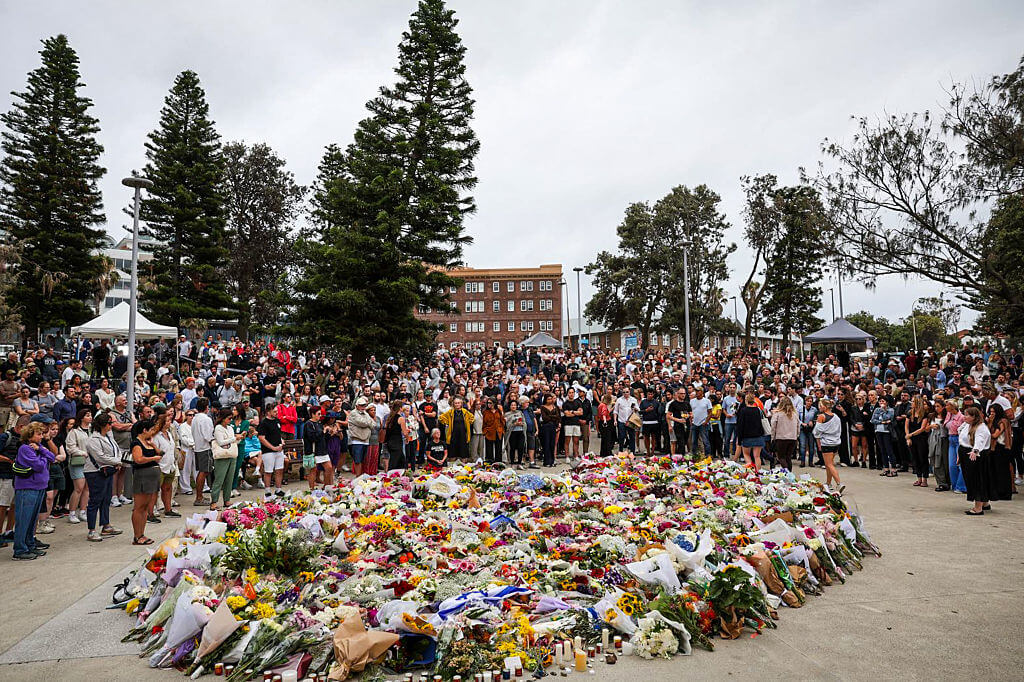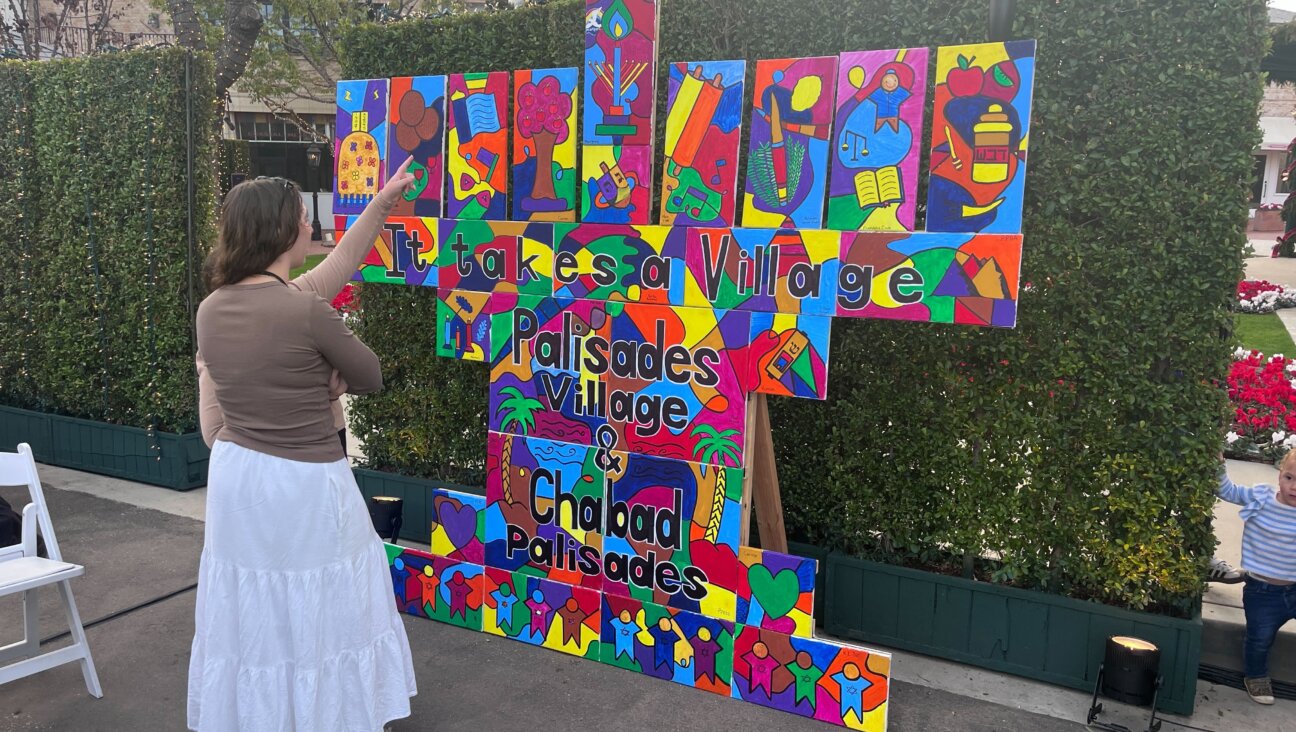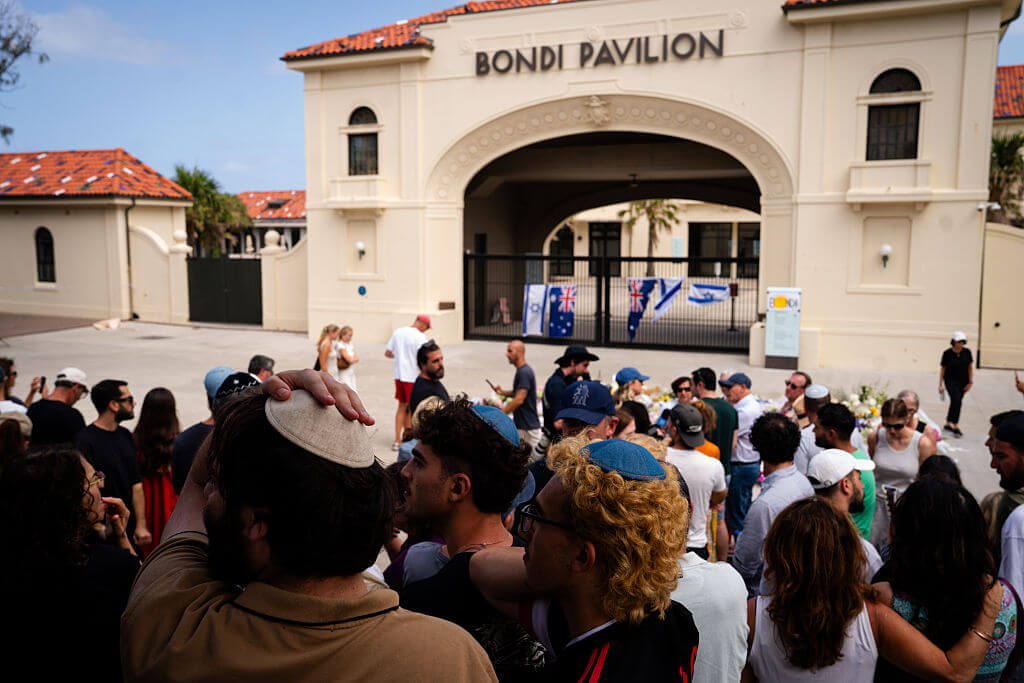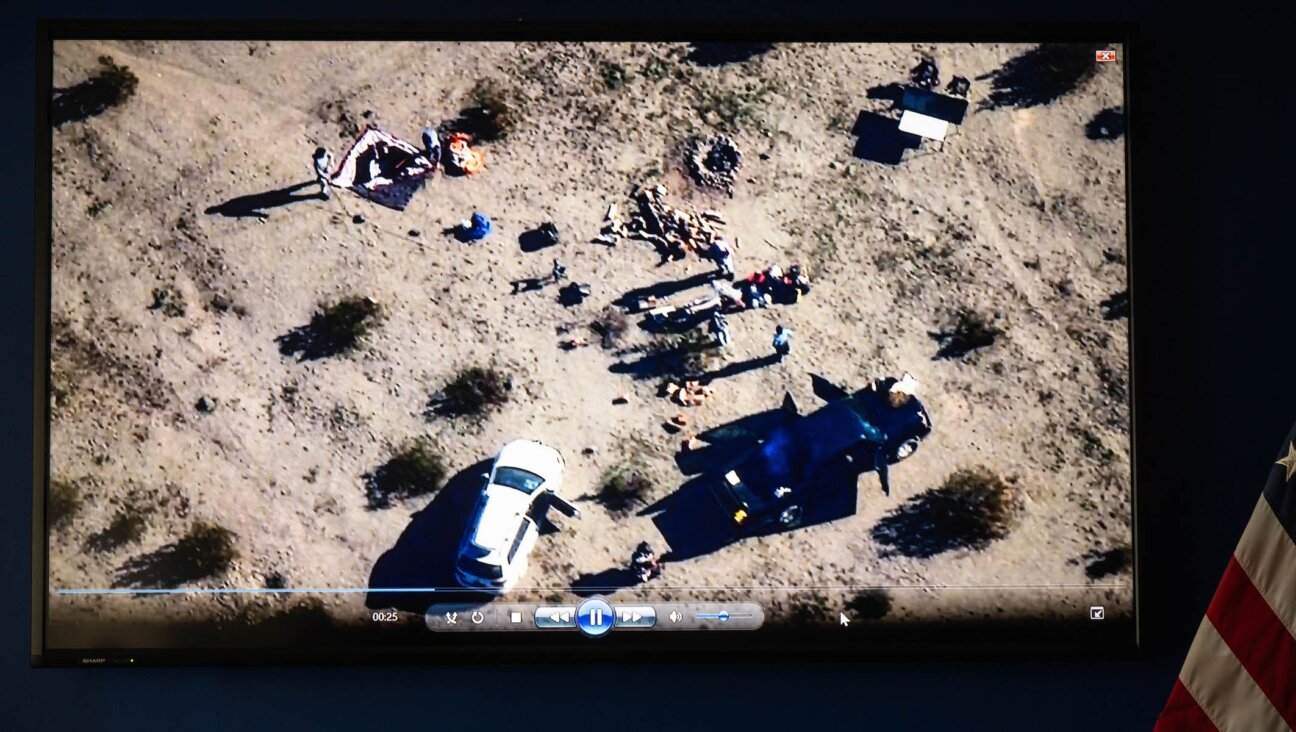Asher Lopatin Gets Less-Than-Warm Welcome From Orthodox World

Image by courtesy of YCT
Rabbi Asher Lopatin is feeling a little “roughed up.”
It’s October 17, less than a fortnight since Lopatin’s official installation as president of Yeshivat Chovevei Torah, a liberal Orthodox rabbinical school in the Bronx, and his attempts to reach out to New York’s Orthodox community are not going well.
Sitting in a cramped office at YCT, Lopatin is replaying the smackdowns and letdowns of the previous few weeks.
First there was the condemnation from the ultra-Orthodox umbrella group, Agudath Israel of America, which savaged Lopatin’s decision to mark his October 6 installation with a roundtable discussion involving leaders from the Reform, Conservative and Reconstructionist movements.
“I am surprised that the Agudah saw the panel… as something that was going to destroy Judaism as we know it,” Lopatin says.
Then there was the absence at Lopatin’s installation ceremony of his colleagues from the flagship Modern Orthodox institution, Yeshiva University. The absentees included several friends and acquaintances who found more pressing engagements that day. “There were a lot of people on the road that Sunday,” Lopatin says.
“Then I was blessed with my Yated Ne’eman article,” he adds.
Lopatin is referring to a lengthy editorial in the ultra-Orthodox newspaper describing YCT’s roundtable as a “spit in the face of Orthodox conduct and practice” and labeling Open Orthodoxy itself as a threat to Judaism.
“They aren’t content with their small group. They seek to expand it and to transform our communities as well,” the newspaper’s editor, Pinchus Lipschutz wrote, adding that Lopatin’s “deviant group” is “drawing adherents and gaining control of shuls, schools and organizations.”
Lipschutz added: “It is high time for our community to formally declare — and really mean it — that Open Orthodoxy is not Orthodoxy and that anyone involved with Open Orthodox institutions risks being ousted from leadership positions in the Orthodox community.”
Lopatin never imagined that gaining acceptance for Open Orthodoxy would be easy. But he seems genuinely surprised — and a little hurt — that the name-calling and shunning has begun already.
“It might be that they feel that we are a player in the Orthodox world,” Lopatin says. “I would like to think really we are such a factor and they are scared.”
It wasn’t supposed to be like this. Lopatin was hailed as a moderating force to counteract YCT’s bullish founder, Rabbi Avi Weiss, who stepped down as president of YCT at the end of June.
Since founding the seminary, in 1999, Weiss has butted heads numerous times with his Orthodox peers over denominational pluralism, the role of women in Orthodoxy, and most famously, his ordination of the first female rabba, Sara Hurwitz, in 2009.
YCT graduates have forged successful careers in pastoral care at schools, colleges and hospitals, Lopatin says. And despite a refusal by Modern Orthodoxy’s Rabbinical Council of America to accept YCT-ordained rabbis as members, 35 YCT graduates have secured pulpit positions in Modern Orthodox synagogues, according to Lopatin.
Still, the friction between YCT and other Orthodox groups persists. The avuncular Lopatin, with his warm, excitable manner, soft voice and penchant for novelty ties was supposed to be the anti-Weiss. Unlike his predecessor, Lopatin, according to the online Jewish magazine, Tablet, “is universally known not as an incendiary but as a relentless bridge-builder.”
Lopatin served for 18 years as spiritual leader of Anshe Sholom B’nai Israel Congregation, in Chicago. His bumpy start in New York prompts him to wonder aloud about his career choice.
His father, George Lopatin, a research chemist, wanted his son to go into Middle East policy planning. “I love what I am doing and I am committed to it,” Lopatin says, “but maybe if I had followed my father’s advice…” He trails off, but goes on to note that Susan Rice was a fellow student during his Oxford University days in the late 1980s, when he earned a master’s degree in medieval Arabic thought.
Lopatin is pained by what he perceives as the lack of attention given to humanitarian crises in places like North Korea and Darfur. “Everyone just dreys in kop about the Middle East,” he says. “Yes, it’s important. But look at Africa — Sudan, Chad, Mali!” Later, Lopatin relates his dream to set up the first kosher restaurant, in Pyongyang, North Korea.
•
Lopatin’s career could have turned out quite differently. A few years ago, he was preparing to emigrate to Israel to start a new Jewish community on the outskirts of Beersheba. But his plans were cut short when Cara, his younger daughter, was diagnosed with cancer. The family stayed in the U.S. and she is in remission.
Although Lopatin’s religious views are famously liberal, his views on Israel are firmly to the right of the American Jewish spectrum. Contrary to Israeli policy, Lopatin believes that Jews should be allowed to pray on the Temple Mount — a contested site sacred to Muslims and Jews that has sparked some of the most violent eruptions in Israel’s history. He also views restrictions on the right of Israeli Jews to reside in Hebron, another powder keg, in the occupied West Bank as undemocratic.
Lopatin says the two-state solution is “the worst thing” for Israelis and for Palestinians. He is a firm advocate for annexing the West Bank and for creating an enlarged State of Israel. (On Gaza, he says in a follow-up phone conversation, “If push came to shove, it’s part of the holy land and I would love for Israelis to live in Gush Katif as well.”)
Lopatin’s views on Israeli demography are influenced heavily by Yoram Ettinger, a former minister of congressional affairs in the Israeli Embassy in Washington, who argues that contrary to government estimates, Jews could be an 80% majority in the area comprising pre-1967 Israel and the West Bank by 2035.
Lopatin says the widely-held fear that a single Israeli state would result in a Jewish minority ruling over an Arab majority is misplaced. Although official Israeli and U.S. figures appear to show that Jews are on the threshold of becoming a minority in the area that encompasses Israel, the West Bank and the Gaza Strip, Lopatin calls the so-called demographic threat to Israel “a myth.”
He adds that at a time when the Modern Orthodox and ultra-Orthodox worlds are wrestling with child sex abuse scandals, “the State of Israel is a beacon of hope for ethics in the world.” He holds up as an example “the way the Israeli army fights… calling civilians to get out of a building because they are bombing the building” — a reference to warnings Israel issued to evacuate some of the buildings it targeted prior to its bombings during its 2008 invasion of Gaza.
By comparison, he says the Jewish community, and the Orthodox community, has “got a lot of work to do.”
•
Lopatin still holds out hope of making up with his Orthodox peers, despite his rough start.
A congregant at the Hebrew Institute of Riverdale, which sits below YCT and where Weiss is the rabbi, has invited Lopatin to attend a forthcoming legislative breakfast organized by the Agudah. Lopatin says he will continue trying to reach out to the Agudah’s Rabbi Avi Shafran and to its executive director Rabbi Dovid Zwiebel who, so far, have not returned his phone calls.
Lopatin has also put out feelers to ultra-Orthodox yeshivas who might be willing to allow YCT students to attend shiurim there. So far, no one has responded, but Lopatin is undeterred. “The Haredi community is part of my movement,” Lopatin says. “They might want to push us out… but we are going to work hard.”
Shortly before lunchtime, Lopatin ambles into YCT’s beit midrash, where about 25 students and teachers are arguing in small groups over the finer points of some midrash. A student approaches Lopatin and, as he listens, Lopatin repeats back softly an affirming “Yeah, yeah,” and “thank you, thank you.”
This will be Lopatin’s first in a series of sichot — or talks — as president of the yeshiva. He moves to the center of the room and tells his staff and students that the topic of his talk will be: “the reaction in Orthodox outlets to the panel [discussion] we had before the installation.”
Lopatin says that although most Jews view YCT rabbis as “Torah Jews” he does not want to “ignore some of the buzz going on.”
Lopatin draws an analogy between those who want to cast Open Orthodoxy out of Judaism today and the Vilna Gaon, who wanted to excommunicate hasidim from Judaism in the 18th century. Lopatin tells his students to stand their ground: to understand their identity as Open Orthodox Jews and, at the same time, to continue trying to connect with the Orthodox community to their right.
“As difficult, distasteful and frustrating as it is, I think it’s important for us as Orthodox students to connect with everyone in the Orthodox world,” Lopatin says. “We need their Torah — not all their Torah, but there is a lot of Torah out there.”
Later, over lunch in a nearby Chinese restaurant, Lopatin says he has been particularly disappointed by the refusal of his Y.U. friends to attend his installation ceremony.
He did not want to name names, but he did want to make clear that he felt personally hurt. One Y.U. acquaintance told Lopatin that he did not make the event because the invitation arrived at the wrong office. Another, who has been a family friend for decades, “just didn’t see it in his ability to attend,” Lopatin says.
“These are people that have to be very careful about what they do. I respect that,” Lopatin said. “Everyone is looking over their right shoulder.”
The most frustrating aspect of the past few weeks has been the number of people who have not returned Lopatin’s phone calls. “That’s a mode of operating that a lot of people have and it’s rude,” Lopatin says.
•
A couple of hours later, Lopatin is heading across the Bronx in a taxi to build bridges in a totally different sphere — at a fellow institute of higher education in the borough.
At Manhattan College, Lopatin is ushered into the offices of its president. Brennan O’Donnell is tall and stately, wearing a conservative suit. He provides a sharp contrast to Lopatin, who is wearing a brightly-colored tie adorned with a portrait of Lopatin, his wife and four children.
As the two men take their seats, O’Donnell points out an artist’s rendering of a new addition to Manhattan College that is currently rising on the 22-acre campus. Then, he fills Lopatin in on the college’s history as a Catholic school, founded in 1853, catering mainly to the poor.
O’Donnell tells Lopatin about the school’s 3,500 students, most of them undergraduates, about its $60 million endowment and huge operating costs. “Oh my gosh,” Lopatin says. “That’s great.” “Right, right, right.” “Wow.” “A-ha.”
When O’Donnell is finished he asks Lopatin about YCT.
Lopatin tells O’Donnell that YCT has a total of 35 students, but he is aiming for 60 in the future. He talks about Open Orthodoxy, about his plans for a preparatory YCT learning program at Israeli yeshivas, and about the need to show that YCT is here to stay, “that it’s not fringe,” Lopatin says. “We’re still working on that.”
“I think the goal is to be the flagship Modern Orthodox rabbinical school.” he adds. “I think we are the best because we really teach independence and creativity.”
Lopatin moves on to tell O’Donnell about his installation ceremony. He describes how Y.U.’s rabbis were “not able to be there” and how YCT was attacked by “Orthodox papers and blogs.”
“I wouldn’t mind the attack at all but I don’t want my students to take that in, to feel they are under attack,” Lopatin says.
O’Donnell is sympathetic. He notes that his own college, founded by the De La Salle Brothers, was for decades at loggerheads with Fordham College in the Bronx, which was founded by Jesuits.
“As you guys know,” O’Donnell told Lopatin, “the most virulent disagreements are in the family.”
Contact Paul Berger at [email protected] or on Twitter @pdberger
















